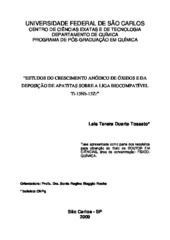Estudos do crescimento anódico de óxidos e da deposição de apatitas sobre a liga biocompatível Ti-13Nb-13Zr
Abstract
Studies on the anodic growth of oxide films passivating the biocompatible alloy Ti-13Nb-13Zr (m/m) and the formation of hydroxyapatite (HA) films on these oxides were carried out in this work. The oxides were grown either potentiodynamically up to 8 V (vs. SCE) or by micro-arc oxidation (MAO) in phosphate buffer electrolyte of pH 5 at room temperature, in order to obtain both compact thin films and porous thick films, respectively. The bioactive films of HA were formed by electrochemical deposition using catodic current density, in solutions containing salts of Ca and P, and by biomimetic method in solutions simulating physiological fluid. The metal/oxide and metal/oxide/HA electrodes were submitted to stability tests as a function of the immersion time in an electrolyte simulating the physiological medium as the PBS solution. The electrochemical parameters of the anodic oxides, with and without the HA films, were analysed by means of electrochemical impedance spectroscopy (EIS) at constant time intervals during the immersion in PBS solution. Analyses of scanning electron microscopy (SEM), dispersive energy X-ray spectroscopy (EDS) and X-ray difractometry were also performed for all electrodes for morphological, compositional and structural characterization of the oxide films/HA before and after the immersion time in PBS solution. The results also revealed that the oxides formed by MAO is the more corrosion resistant in a chloride-containing medium, the HA coating obtained by electrodeposition presents higher corrosion resistance when formed on the compact oxide, and the oxide obtained by MAO presents higher corrosion resistance when the apatite coating is obtained by the biomimetic method.
